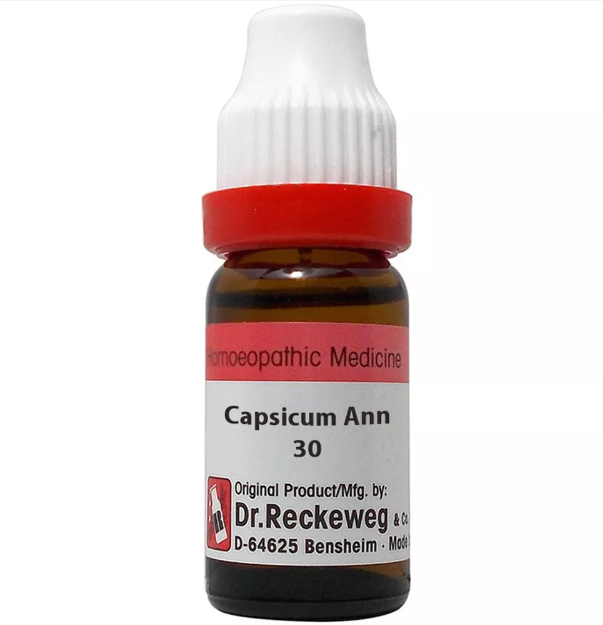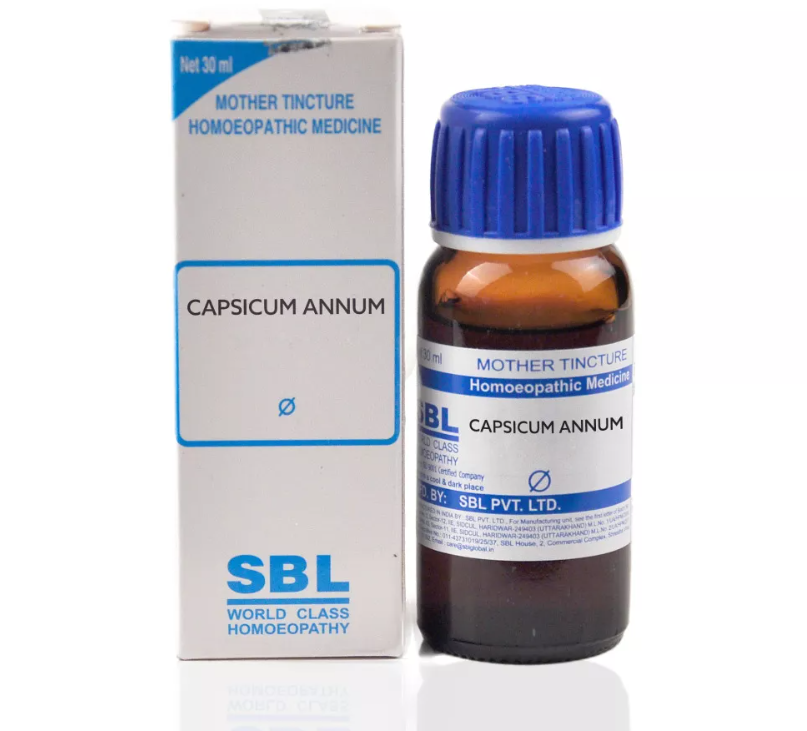CAPSICUM ANNUUM Q, 6C, 12C, 30C, 200C, 1M, 10M USES AND SYMPTOMS
 Capsicum Annuum
Capsicum Annuum
(Cayenne Pepper)
Caps.
Suited for individuals with weak vitality, sluggishness, and coldness. Beneficial for those who are overweight, inactive, avoid physical exertion, and get homesick easily. Common in people with poor hygiene and those who have stopped drinking alcohol. Affects mucous membranes, causing a constricted feeling. Induces inflammation of the petrous bone, burning pains, and general chilliness. Often helps older people who are exhausted, especially from mental work or poor living conditions, who show no reaction to stimuli and fear slight drafts. Tends to cause suppuration in inflammations, prostration, and weak digestion in alcoholics. Symptoms include myalgia, muscle aches, and jerks.
Mind:
Excessive irritability, homesickness with insomnia, suicidal tendencies, desire for solitude, irritable disposition, and delirium tremens.
Head:
Bursting headache worsened by coughing, hot face, red cheeks, and a cold yet red face.
Ears:
Burning and stinging sensations, swelling and pain behind ears, mastoid inflammation, extreme tenderness over the petrous bone, otorrhea, and pre-suppurative mastoid disease.
Mouth:
Herpes labialis, stomatitis, unpleasant mouth odor, and halitosis.
Throat:
Hot sensation, subacute eustachian tube inflammation with pain, sore and dry throat extending to the ears, sore throat in smokers and drinkers, smarting, and burning constriction worsened between swallowing acts. Inflamed and swollen uvula and palate.
Stomach:
Burning at the tongue tip, atonic dyspepsia, flatulence, intense craving for stimulants, vomiting, sinking sensation at the stomach pit, marked thirst but shuddering upon drinking.
Stool:
Bloody mucus with burning and tenesmus, back pain after stool, thirst and shivering post-stool, bleeding piles, and stinging pain during stool.
Urinary:
Strangury, frequent but ineffective urging, burning at the orifice, spasmodic contraction of bladder neck, and ectropion of the meatus.
Male:
Cold scrotum with impotence, atrophied and insensitive testicles, gonorrhea with excessive burning and pain in the prostate.
Female:
Climacteric disturbances with tongue tip burning, uterine hemorrhage near menopause with nausea, and sticking sensation in the left ovarian region.
Respiratory:
Chest constriction, hoarseness, apex heart pain or rib pain worsened by touch, dry hacking cough, dyspnea, explosive cough, gangrene threat in lungs, and distant pain on coughing.
Extremities:
Pain from hips to feet, sciatica worsened by bending backward and coughing, and knee tensive pain.
Fever:
Coldness with ill humor, shivering post-drinking, chills starting in the back, improved by heat, needing hot items on the back, and thirst before chills.
Modalities:
Improved by eating and heat. Worsened by open air, uncovering, and drafts.
Relationship:
Antidotes: Cina, Caladium. Comparable to Pulsatilla, Lycopodium, Belladonna, and Centaurea tagana.
Dose: Third to sixth attenuation. For delirium tremens, dram doses of tincture in milk or tincture of orange peel.
SYMPTOMS OF CAPSICUM ANNUUM
Mind:
Excessive irritability
Homesickness with insomnia and suicidal tendencies
Desire for solitude
Irritable disposition
Delirium tremens
Head:
Bursting headache worsened by coughing
Hot face and red cheeks
Red face that feels cold
Ears:
Burning and stinging sensations
Swelling and pain behind the ears
Mastoid inflammation
Extreme tenderness over the petrous bone
Otorrhea and pre-suppurative mastoid disease
Mouth:
Herpes labialis
Stomatitis
Unpleasant mouth odor and halitosis
Throat:
Hot sensation
Subacute eustachian tube inflammation with pain
Sore and dry throat extending to the ears
Sore throat in smokers and drinkers
Smarting and burning constriction worsened between swallowing
Inflamed and swollen uvula and palate
Stomach:
Burning at the tongue tip
Atonic dyspepsia
Flatulence
Intense craving for stimulants
Vomiting and sinking sensation at the stomach pit
Marked thirst but shuddering upon drinking
Stool:
Bloody mucus with burning and tenesmus
Back pain after stool
Thirst and shivering post-stool
Bleeding piles and stinging pain during stool
Urinary:
Strangury and frequent but ineffective urging
Burning at the orifice
Spasmodic contraction of bladder neck
Ectropion of the meatus
Male:
Cold scrotum with impotence
Atrophied and insensitive testicles
Gonorrhea with excessive burning and prostate pain
Female:
Climacteric disturbances with tongue tip burning
Uterine hemorrhage near menopause with nausea
Sticking sensation in the left ovarian region
Respiratory:
Chest constriction
Hoarseness
Apex heart pain or rib pain worsened by touch
Dry hacking cough
Dyspnea
Explosive cough
Gangrene threat in lungs
Distant pain on coughing
Extremities:
Pain from hips to feet
Sciatica worsened by bending backward and coughing
Tensive pain in the knee
Fever:
Coldness with ill humor
Shivering post-drinking
Chills starting in the back, improved by heat
Needing hot items on the back
Thirst before chills
Modalities:
Improved by eating and heat
Worsened by open air, uncovering, and drafts
Relationship:
Antidotes: Cina, Caladium
Comparable to Pulsatilla, Lycopodium, Belladonna, and Centaurea tagana
selection of the potency
Individualization:
- Homeopathy is based on the principle of treating the individual, not just the disease. The unique symptoms and characteristics of the person are crucial in determining the most suitable potency.
Intensity of Symptoms:
- The intensity of the symptoms guides the choice of potency. If the symptoms are intense and acute, a lower potency (e.g., 6C, 30C) might be considered. For chronic conditions with less intensity, higher potencies (e.g., 200C, 1M) may be appropriate.
Sensitivity of the Patient:
- Some individuals are more sensitive to homeopathic remedies, while others may require higher potencies. The practitioner considers the patient’s sensitivity when selecting the potency.
Acute vs. Chronic Conditions:
- Lower potencies are often used for acute conditions, while higher potencies may be considered for chronic or long-standing issues.
Previous Response to Potencies:
- The patient’s response to previous homeopathic treatments helps guide the choice of potency. If a particular potency has been effective in the past, it may be repeated or adjusted as needed.
Vital Force and Susceptibility:
- Homeopathy views illness as a disturbance in the vital force. The practitioner assesses the patient’s overall vitality and susceptibility to determine the appropriate potency.
Aggravation or Amelioration:
- The direction of the symptom response (aggravation or amelioration) after taking a remedy can influence the choice of potency.
Miasmatic Considerations:
- In classical homeopathy, the concept of miasms (inherited disease tendencies) is considered. The practitioner take this into account when selecting the potency.
Practitioner Experience:
- The experience and preference of the homeopathic practitioner play a role. Some practitioners may have success with certain potencies based on their clinical experience.
SAFETY INFORMATION
- Do not exceed the recommended dose by physician
- Keep out of the reach of children
- Store in a cool dry place away from direct sunlight
- Maintain half an hour gap between food/drink/any other medicines and homoeopathic medicine
- Avoid any strong smell in the mouth while taking medicine e.g. camphor, garlic, onion, coffee, hing
Medicine images use for reference only selection of homeopathic medicine depends on the individual’s specific symptoms and overall constitution. Moreover, homeopathy is a holistic system of medicine that treats the individual as a whole. In addition to addressing the physical symptoms, it takes into account the emotional and mental state of the person. Consequently, it’s crucial to consult with a qualified homeopathic practitioner for personalized treatment.
The information provided on this website is intended solely for educational purposes. Always seek the advice of your physician or other qualified health provider.
